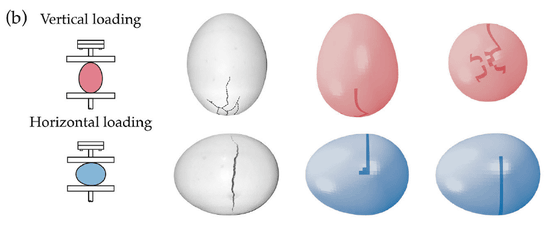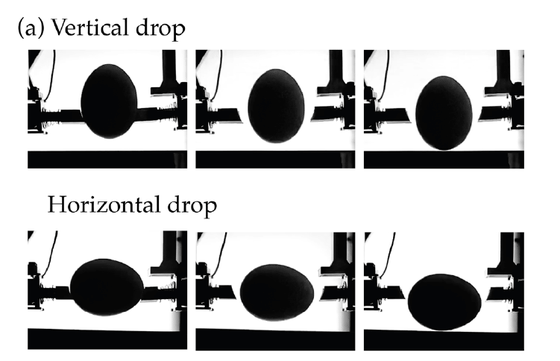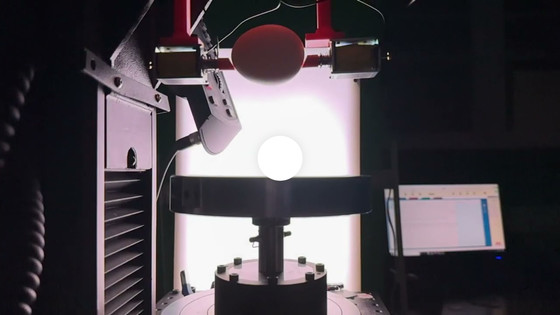Eggs are less likely to break if they fall sideways

An egg is oval in shape and is said to be strong against vertical forces but weak against horizontal forces. However, a student team at Massachusetts Institute of Technology (MIT) announced the results of an experiment that showed that an egg is less likely to crack if it is dropped sideways.
Challenging common notions on how eggs break and the role of strength versus toughness | Communications Physics
MIT engineering students crack egg dilemma, finding sideways is stronger | MIT News | Massachusetts Institute of Technology
https://news.mit.edu/2025/mit-engineering-students-crack-egg-dilemma-sideways-stronger-0508
When cracking an egg to make fried eggs for breakfast, it is easier to crack if you hit it sideways than vertically. Traditionally, eggs have been said to be stronger against vertical forces than lateral forces, and it has also been thought that eggs are less likely to crack if dropped vertically.
In MIT's Department of Civil and Environmental Engineering, a first-year course is being taught on the topic of 'egg dropping.' The course is designed to explore how to prevent eggs from breaking when dropped, using scientific literature as a reference. 'About three years ago, I started to wonder whether a vertical drop was really strong enough,' says Tal Cohen, an associate professor in the Department of Civil and Environmental Engineering.
So, Cohen and his team bought a carton of 60 eggs from Costco and conducted an experiment. The team let the eggs come to room temperature and visually inspected them to select eggs that were free of cracks. The average egg size was 56mm long, 44mm wide, and weighed 59g.
Two types of experiments were carried out. The first was a static compression test, in which an egg was placed on a fixed platen and compressed by the upper platen. The egg was fixed either vertically or horizontally, and the upper platen moved downward at 10 mm per minute to compress the egg. The researchers continued to compress the egg until it cracked, recording the force, time and displacement.

As a result, the maximum load in the vertical position was 46.0 ± 6.61 N (Newtons), and the maximum load in the horizontal position was 45.2 ± 5.52 N. The research team argues that 'there was no statistically significant difference in the maximum load regardless of the orientation of the eggs.' On the other hand, the maximum displacement was 0.161 ± 0.015 mm in the vertical position and 0.213 ± 0.022 mm in the horizontal position. This indicates that horizontal eggs deform more before breaking than vertical eggs.
The second experiment was a dynamic drop test. The team dropped the eggs from three heights - 8mm, 9mm, and 10mm - in three orientations: horizontal, vertical with the sharp end up, and vertical with the sharp end down, 20 times for each orientation, for a total of 180 tests. The eggs were held in place by

The results showed that the rate of eggs that cracked was lowest when dropped horizontally at all heights. For example, in a drop test from a height of 8 mm, only 5% of eggs cracked when dropped horizontally, but about 55% of eggs cracked when dropped vertically, regardless of whether the sharp edge was up or down. Even at a height of 10 mm, about 45% of eggs cracked horizontally, while about 80% of eggs cracked vertically, regardless of the orientation.
The research team argued that while no statistically significant difference was found between the top and bottom of the sharp edge when the glass was oriented vertically, there was a clear difference when comparing vertical and horizontal orientations, with the horizontal orientation being statistically significantly less likely to break.
In addition, the team conducted a computer simulation of the two experiments, and the results matched those of the actual experiments. In particular, the force and displacement transitions and crack patterns were reproduced in virtual space. From these results, the team concluded that dropping an egg sideways was less likely to cause it to crack.
The research team claims that the common belief that 'eggs are less likely to break when dropped vertically' is correct, because both experiments and numerical simulations have confirmed that the stiffness of eggs is higher when loaded vertically. However, they point out that 'this does not mean that eggs can withstand greater forces in the vertical direction,' and argue that the conclusion that 'eggs can withstand higher forces in the vertical direction and therefore are less likely to be destroyed upon impact' was incorrect.

The research team argues that the misunderstanding has arisen because the definition of the word 'strength' of eggs has been unclear. Rigidity is the ability to resist deformation, but what determines whether an egg is resistant to breaking when dropped is its ability to absorb energy, or toughness. In other words, what is important when dropped is not how hard it is, but how much energy it can absorb. The research team argues that the results of this experiment showed that eggs can absorb more energy when laid sideways, which means they are less likely to break.
'Our paper is a reminder of the value of challenging accepted notions and relying on empirical evidence rather than intuition,' said Associate Professor Cohen. 'We hope that our research will inspire students to remain curious, question even their most familiar assumptions, and think critically about the physical world around them. That's what we aim to do in our group: to continually challenge what they're taught through thoughtful inquiry.'
Related Posts:
in Science, Posted by log1i_yk







